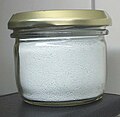Position in the crystal structure
![Some hydrogen-bonding contacts in
.mw-parser-output .template-chem2-su{display:inline-block;font-size:80%;line-height:1;vertical-align:-0.35em}.mw-parser-output .template-chem2-su>span{display:block;text-align:left}.mw-parser-output sub.template-chem2-sub{font-size:80%;vertical-align:-0.35em}.mw-parser-output sup.template-chem2-sup{font-size:80%;vertical-align:0.65em}
FeSO4*7H2O. This metal aquo complex crystallizes with water of hydration, which interacts with the sulfate and with the
[Fe(H2O)6] centers. H-bondingFeSO47aq.tif](http://upload.wikimedia.org/wikipedia/commons/thumb/4/44/H-bondingFeSO47aq.tif/lossless-page1-400px-H-bondingFeSO47aq.tif.png)
A salt with associated water of crystallization is known as a hydrate . The structure of hydrates can be quite elaborate, because of the existence of hydrogen bonds that define polymeric structures. [3] [4] Historically, the structures of many hydrates were unknown, and the dot in the formula of a hydrate was employed to specify the composition without indicating how the water is bound. Per IUPAC's recommendations, the middle dot is not surrounded by spaces when indicating a chemical adduct. [5] Examples:
- CuSO4·5H2O – copper(II) sulfate pentahydrate
- CoCl2·6H2O – cobalt(II) chloride hexahydrate
- SnCl2·2H2O – tin(II) (or stannous) chloride dihydrate
For many salts, the exact bonding of the water is unimportant because the water molecules are made labile upon dissolution. For example, an aqueous solution prepared from CuSO4·5H2O and anhydrous CuSO4 behave identically. Therefore, knowledge of the degree of hydration is important only for determining the equivalent weight: one mole of CuSO4·5H2O weighs more than one mole of CuSO4. In some cases, the degree of hydration can be critical to the resulting chemical properties. For example, anhydrous RhCl3 is not soluble in water and is relatively useless in organometallic chemistry whereas RhCl3·3H2O is versatile. Similarly, hydrated AlCl3 is a poor Lewis acid and thus inactive as a catalyst for Friedel-Crafts reactions. Samples of AlCl3 must therefore be protected from atmospheric moisture to preclude the formation of hydrates.
![Structure of the polymeric
[Ca(H2O)6] center in crystalline calcium chloride hexahydrate. Three water ligands are terminal, three bridge. Two aspects of metal aquo complexes are illustrated: the high coordination number typical for
Ca and the role of water as a bridging ligand. Ca(aq)6 improved image.tif](http://upload.wikimedia.org/wikipedia/commons/thumb/5/51/Ca%28aq%296_improved_image.tif/lossless-page1-250px-Ca%28aq%296_improved_image.tif.png)
Crystals of hydrated copper(II) sulfate consist of [Cu(H2O)4]2+ centers linked to SO2−4 ions. Copper is surrounded by six oxygen atoms, provided by two different sulfate groups and four molecules of water. A fifth water resides elsewhere in the framework but does not bind directly to copper. [6] The cobalt chloride mentioned above occurs as [Co(H2O)6]2+ and Cl−. In tin chloride, each Sn(II) center is pyramidal (mean O/Cl−Sn−O/Cl angle is 83°) being bound to two chloride ions and one water. The second water in the formula unit is hydrogen-bonded to the chloride and to the coordinated water molecule. Water of crystallization is stabilized by electrostatic attractions, consequently hydrates are common for salts that contain +2 and +3 cations as well as −2 anions. In some cases, the majority of the weight of a compound arises from water. Glauber's salt, Na2SO4(H2O)10, is a white crystalline solid with greater than 50% water by weight.
Consider the case of nickel(II) chloride hexahydrate. This species has the formula NiCl2(H2O)6. Crystallographic analysis reveals that the solid consists of [trans-NiCl2(H2O)4] subunits that are hydrogen bonded to each other as well as two additional molecules of H2O. Thus one third of the water molecules in the crystal are not directly bonded to Ni2+, and these might be termed "water of crystallization".


